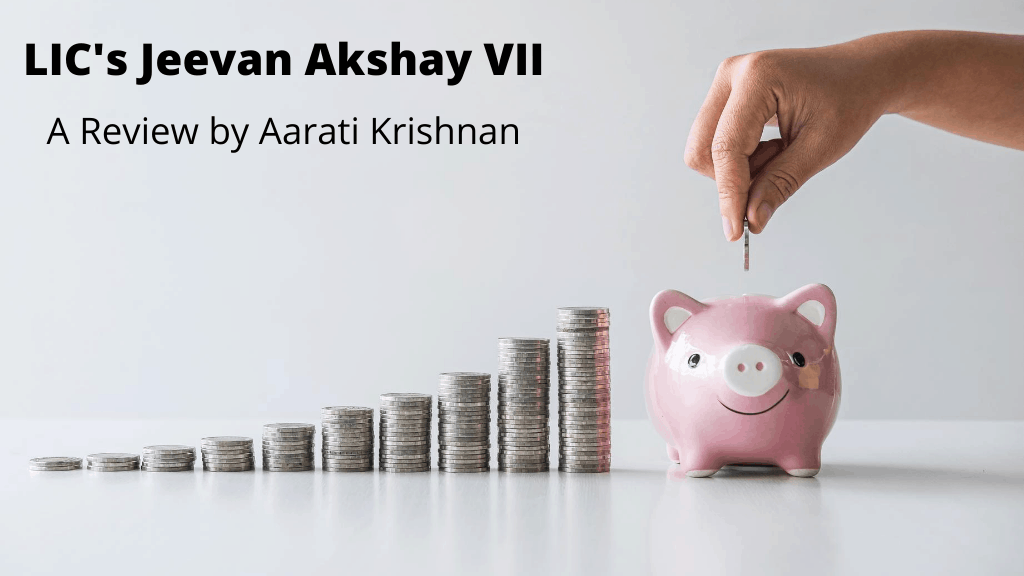Immediate annuity plans are among the few categories of insurance products – apart from pure term covers – that offer real utility to investors. Given their moderate returns, they may not be everyone’s cup of tea, but they are certainly suitable for retirees looking to set up an absolutely predictable stream of income for their basic expenses. Read this article to know who should be buying these plans.
LIC has this week launched Jeevan Akshay 7 – the latest version of its popular immediate annuity plan. So should retirees looking for regular income go for it? Here’s an analysis of its pros and cons.

What’s an immediate annuity?
Immediate annuity plans are among the rare classes of insurance products that sound more complicated than they are. An immediate annuity plan is simply a plan where you pay the insurer a lumpsum amount at the very start of your policy, and the insurer promises to pay you a monthly pension as long as you live, at a guaranteed rate.
The initial lumpsum investment you make is called the purchase price. The monthly pension is called an annuity. It’s an ‘immediate’ annuity because your pension payout starts from the very next month after you buy the policy.
LIC’s immediate annuity plans which are quite a hit with retirees were usually sold under the Jeevan Akshay series. But LIC discontinued this series in 2017 with the launch of Jeevan Shanti, a plan which offered both immediate and deferred annuity plans. With effect from August 2020, Jeevan Shanti will no longer offer an immediate annuity option. LIC has instead revived and launched Jeevan Akshay VII as its sole immediate annuity product.
Features of Jeevan Akshay 7
Payouts: When you make an upfront investment in Jeevan Akshay 7, LIC promises to pay you a guaranteed pension at a fixed rate for the rest of your life. You can opt to receive this pension at a monthly, quarterly, half yearly or annual frequency. The annuity will be paid as long as you live. The pension payouts start in the very next period after you make your investment but do note that they are paid in arrears. So, if you buy the monthly plan at the beginning of September 2020, your pension payouts will start from the end of October 2020.
Entry age: The minimum age at which you can buy Jeevan Akshay 7 is 30 years and the maximum age is 85 years. Only for one of the available options (annuity for life with return of purchase price) the maximum age of entry is 100.
Minimum investment: The minimum upfront investment (purchase price) is Rs 1 lakh and there are no maximum limits. If you invest Rs 5 lakh or more, you get a higher annuity rate as an incentive. Buying this plan online also fetches you a 2% increase in the basic annuity rate.
Do note that GST at 1.8% of the initial investment is applicable to immediate annuity plans. Effectively, if you purchase the annuity for an initial Rs 10 lakh, you will have to shell out Rs 10,18,000 to the insurer.
Taxation: The pension or annuity you receive is also taxed at your Income Tax slab rate just like other fixed income products. Benefit illustrations of annuity plans usually don’t capture either the upfront GST impact or the taxes on the pension.
Choosing the option
Simple as immediate annuity plans seem, insurers offer multiple options on their menu within these plans. Jeevan Akshay 7 offers the following options.
Option A represents the simplest product where you pay the purchase price to LIC and LIC pays you a fixed pension as long as you live (you do not get back your principal).
But what happens if you shell out a big lumpsum to purchase an immediate annuity and are unfortunate enough to die the very next month? To pre-empt this contingency, LIC offers plans where your nominees are guaranteed a pension payout for the first 5, 10, 15 and 20 years, if you don’t survive this period. This is what is captured in options B, C, D and E above.
A plain vanilla annuity product (option A) does NOT return your initial investment. But many folks are uncomfortable with the notion of allowing the insurer to pocket their initial lumpsum in the event of their early demise. Annuity options with ‘return of purchase price’ solve this problem. They promise to pay your nominees your initial purchase price in the event of your death. Option F above captures this choice. This is also suitable if you want to leave your heirs a lumpsum after your death.
By default, annuity plans only promise to pay you a fixed sum every month. They do not adjust your pension for inflation over your retired years. Option G, which increases your annuity at a simple rate of 3% pa partly addresses this problem. But do note that it offers little protection against inflation because the 3% does not compound. If you start with a monthly pension of Rs 10,000 in the first year, you will receive Rs 300 as the increase every year. This may not be sufficient to take care of inflation.
Would you like to ensure pension not just for yourself but also your spouse after your passing? Options H, I and J should then be your choice as they promise to continue annuity payments to your spouse after your death at 50 or 100%. The last option J not only pays pension to your spouse but also returns the purchase price to nominees after the demise of your spouse.
But while all the bells and whistles offered by options B to J may seem tempting, do note that they result in a lower pension. It is the plain vanilla lifelong annuity without return of purchase price (option A), which fetches you the highest monthly pension for every Rupee you invest.
Maximising your pension
The following table captures annuity rates published by LIC under different options for a Rs 10 lakh purchase price (initial investment) for an investor who is 55 when he buys Jeevan Akshay 7.
The above table shows that for the same purchase price of Rs 10 lakh, your pension amount would be significantly lower if you opt for a minimum number of guaranteed years or return of purchase price.
- If your sole aim is to maximise your monthly pension and that’s more important than leaving money to your heirs, options A and I should be your top choices.
- With most investment products, you are advised to enter early to maximise your returns. In immediate annuity products, delaying the purchase works in your favour. The older you are while buying an immediate annuity plan, the higher the pension you receive from the insurer! This is because the effective outgo for the insurer in this product depends on your longevity – the later you buy the plan, the fewer years the insurer has to pay pension.
The below table demonstrates that a person investing in Jeevan Akshay VII at 60 years of age, would earn 37% more pension than the one buying the product at 30, for an identical purchase price.
How returns compare
Finally, how does Jeevan Akshay 7 compare to other fixed income products on returns? Well, the annuity rate is a simplistic measure, but the best way to figure out the compounded annual return from an immediate annuity product is to use the XIRR calculation.
Using the XIRR calculation on four options – Lifelong pension for you, Lifelong pension with return of capital for you, lifelong pension for you and spouse, lifelong pension for you and spouse with return of capital- the effective returns from the plan work out to anywhere between 5.21% pa and 6.71% pa. Refer to this excel sheet for calculations.
There are three points to take note of from the above calculation.:
- The longer you live, the better your returns from this product. Even living to 90 instead of 85 makes a big difference to your returns
- Opting for lifelong pension without return of purchase price significantly bumps up your returns, if you live reasonably long. Here we have added in the sum received by your heirs to calculate returns.
- All the pension numbers and returns mentioned above are before tax. If you expect to fall in the taxable slab post-retirement, you will need to adjust the above pension/returns for taxes at your income tax slab rate. At a 20% slab, a 6.71% return falls to 5.4% and at the 30% slab it falls to 4.7%.
They also show that while Jeevan Akshay VII delivers guaranteed lifelong pension with negligible need to worry about rates or manage your money, investing in it requires you to make a significant sacrifice on the income you earn from your limited capital.
The returns are quite low compared to equally safe fixed income options available today such as RBI floating rate bonds (7.15%), the post office senior citizens savings scheme (7.4%) and post office monthly income account (6.6%).
Using the plan
Of the immediate annuity plans in the market, LIC’ Jeevan Akshay 7 is a top choice because of its competitive annuity rates taken with Central Government backing and sovereign guarantee which make it a trust-worthy vehicle to park such a large lumpsum for such a long period.
- With their predictable cash flows but low effective returns, immediate annuity plans are clearly for investors who cannot actively manage their money post-retirement and value certainty of income over bang for every buck.
- They may also be for you if you actively believe that interest rates in India will head steadily lower in the long run, tracking the plunge in developed markets. A good strategy to tradeoff the low returns on such plans with the need for healthy retirement income would be to use an immediate annuity plan to set up a bare minimum income post-retirement, while layering on post office products, FDs and debt/equity mutual funds for a kicker to those returns.
- If you decide to invest in this plan, it would pay not to invest your entire retirement proceeds today, but to stagger purchases over the years to make the most of a possible rebound in interest rates. Annuity rates on LIC’s plans usually track gilt yields in the market fairly closely. Today, gilt yields in India are at rock-bottom (close to 6%) in the current interest rate downcycle; they have gone as high as 8% in previous cycles. If your income needs are immediate, invest a portion (say a fourth) of your retirement proceeds in Jeevan Akshay today and time the rest of your purchases to an improvement in gilt yields.
Here’s a review of HDFC Life Sanchay Plus, another annuity product
Also Read : How the bonus rate of LIC works








25 thoughts on “Prime Review: LIC Jeevan Akshay VII”
Perfect analysis. Very useful.
🙏
Very well detailed analysis for us to help to take the decision easily !!
🙏 we try to make our reviews actionable!
Hi, Option-A & I comparison table does not mention its annual or monthly pension value. May be update needed?
Thanks Siva
Sorry that’s annual.pension.
WoW, Superb articulation and comparative study with neat analysis. Way to go mam! Thanks Siva
Thank you!
Nicely articulated and explained in a very simple way. Thanks for this. I m sure i haven’t made a mistake by joining as a Prime subscriber
😊
Thank you!
Detailed analysis and clear recommendations. Great Job. Thanks
Thanks!
Jeevan Akshay VII. Analysed well so that ordinary persons can understand it better.
Sudhakarudu
👍
You have compared post tax returns of Jeevan Akshyay with pre tax returns on RBI bonds and SCSS, it distorts the whole picture as returns on RBI bonds and SCSS are also taxable,
It’s not a direct comparison but yes, we will rectify it as the line can be misleading.
It is a complicated product. Not worth according to me. In stead RBI floating bonds, Post office MIS are safe yet gives decent if not great return
Good Analysis. Thanks. Can this policy be taken for a sibling? If I want to fund this annuity for my sibling who is elder to me so that I need not regularly support her financially, is that possible?
Yes should be possible.
Comments are closed.